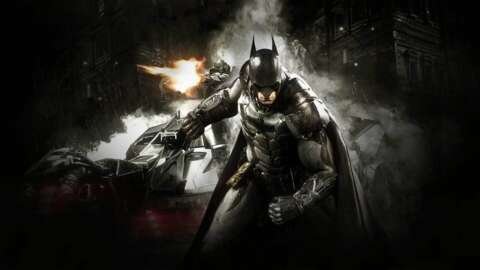GameSpot may receive revenue from affiliate and advertising partnerships for sharing this content and from purchases through links.
Batman: Arkham Knight is celebrating its 10-year anniversary today, June 23, 2015. Below, we look at how it raised the bar for not only superhero games, but for the third act in video game trilogies.
There’s an old adage that good things come in threes, and that’s an idea that applies perfectly to Batman: Arkham Knight. Rocksteady’s final chapter in its Caped Crusader saga turned 10 years old this week, and it’s still a masterpiece of superhero action that has stood the test of time. There’s a lot to love about the game, from its dark storyline to its shocking twists–the Arkham Knight was a red hood herring–and more, but the lasting legacy of the game is that it solved the problem of video game trilogies a decade ago.
Here’s a familiar scenario: You fire up the third game in a beloved series, ready to be wowed. It’s good. You’re having fun. But you can’t shake the feeling that you’ve done it all before. “More of the same” is a common criticism against video game trilogies’ final chapters–but it’s one Arkham Knight skillfully sidestepped.
If Arkham Asylum laid the foundation, then Arkham City was the stately Wayne Manor built atop it–bigger, bolder, and more refined. But by the time Arkham Knight came around, there were fears of fatigue. It followed the release of Batman: Arkham Origins in 2013 by Warner Bros. Montreal, which wasn’t part of Rocksteady’s trilogy but received considerably less acclaim. Could Rocksteady keep the momentum going?

It did–by pushing every idea of its Batman to the extreme.
Arkham Knight is a finely tuned power fantasy built on three pillars: detective work, stealth, and bone-crunching combat. One moment you’re reconstructing crime scenes with high-tech forensic tools; the next, you’re a silent predator stalking armed militia; and then you’re diving into balletic brawls that stitch gadgets and combos into a brutal symphony of chaos.
At this stage, Rocksteady trusted players to know how to be Batman. And in return, it gave them the tools to break past the limits of earlier games. Combat flowed with graceful brutality as you weaved through enemies using freeze grenades, shock rounds, and precision counters. In stealth segments, the fear mechanic hit new highs, as nothing quite matched the rush of trapping a squad of militants with a smoke bomb cloud and then quickly eliminating them one by one using new gameplay mechanics.
But the game didn’t just empower players–it challenged them. With the Arkham Knight and his private army escalating the threat level, players had to evolve. Rocksteady walked the razor’s edge between power fantasy and overpower fantasy, and never lost its balance along the way.

Then there was the Batmobile. What if Batman were a car? That’s the question Rocksteady answered by transforming Gotham’s most iconic vehicle into a game-changing mechanic. Not just a way to move across the city, the Batmobile became an extension of the Dark Knight himself–solving puzzles, charging into battles, and even taking on tanks. There’s something surreal and satisfying about sneaking up on Deathstroke’s armored convoy in a 1,200bhp crime-fighting machine that could somehow still meet strict European noise-pollution requirements.
In the end, Batman: Arkham Knight is more of the same, but pushed to its absolute extreme. It’s a fitting finale to the Arkhamverse–especially if you choose to ignore Suicide Squad: Kill the Justice League–and a celebration of Batman that still shines a decade later.

If you’re looking to grab the game and celebrate its anniversary, then now is a great time to do so. The Arkham Knight Premium Edition regularly sells for an absurdly low price–GOG has a DRM-free version for just $6 as part of its 2025 Summer Sale–and it’s incredibly good value for money. Not only do you get the base game, but there’s a Batcave of DLC to dig into that ranges from challenge maps to standalone episodes focusing on Nightwing, Robin, Batgirl, Red Hood, Catwoman, and Harley Quinn.
If you’ve picked up a Switch 2, the game has also been substantially improved on the Nintendo platform as part of the Arkham Trilogy. According to Digital Foundry, it’s not entirely perfect, but it does run at a locked and mostly stable 30fps when compared to the sluggish performance on the original Switch.
Got a news tip or want to contact us directly? Email news@gamespot.com
